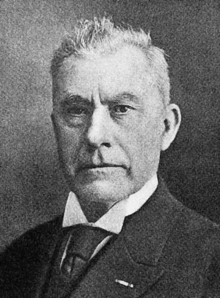Martinus Willem Beijerinck
Martinus Willem Beijerinck (born March 16, 1851 in Amsterdam , † January 1, 1931 in Gorssel ) was a Dutch microbiologist and in his later years the first professor of microbiology at the Delft University of Technology . Its official botanical author abbreviation is “ Beij. ". Bacteriologists name him in the same breath as Louis Pasteur , although he was less well known because he was not concerned with human diseases. His name stands for outstanding research into the properties of yeast, nitrogen production, alcohol production and the role of lactic acid bacteria. He is considered one of the pioneers and co-founders of virology .
Live and act
Beijerinck first studied botany and dealt with the microbiology of plants. He later specialized in the isolation and culture of microorganisms from environmental samples.
His most important merits are the development of the enrichment culture for microorganisms and the virus concept . With his enrichment cultures he was the first to isolate and describe a large number of soil and aquatic microorganisms.
In 1885 he was appointed director of a newly established laboratory at the Nederlandsche Gist- & Spiritusfabriek NV in Delft. He also worked as a lecturer at the Agricultural University in Wageningen and had been elected a member of the Royal Academy of Sciences in Amsterdam a year earlier .
In 1924 he was elected a corresponding member of the Russian Academy of Sciences . In 1929 he became an honorary member of this academy.
In 1898 Beijerinck worked on the tobacco mosaic disease and discovered that the pathogen could be ultrafiltered. Both the German Adolf Mayer in 1882 and the Russian Dimitri Iwanowski in 1892 had also described this before . The pathogen was later characterized as a tobacco mosaic virus . Beijerinck initially called the phenomenon “contagium vivum fluidum” because he recognized it as an infectious agent that could pass bacteria- proof filters and needed living plant cells to reproduce. He thus described the most important principles of modern virology . In addition, he was the first to isolate the bacterium Azotobacter chroococcum , which is able to fix molecular nitrogen .
In 1970 the lunar crater Beijerinck was named after him.
literature
- G. van Iterson, LE den Dooren de Jong, AJ Kluyver: Martinus Willem Beijerinck, his life and his work . Science Tech, Madison, Wis. 1983, ISBN 0-910239-02-9 .
- King-Thom Chung, Deam Hunter Ferris: Martinus Willem Beijerinck (1851-1931), Pioneer of general microbiology. In: ASM News. Vol. 62, No. 10, 1996, pp. 539-543. (PDF)
- MW Beijerinck: About oligonitrophilic microbes. In: Centralblatt for Bacteriology, Parasitology, Infectious Diseases and Hygiene. Division II. Volume 7, 1901, pp. 561-582.
- Sally Smith Hughes: Beijerinck, Martinus Willem . In: Charles Coulston Gillispie (Ed.): Dictionary of Scientific Biography . tape 15 , Supplement I: Roger Adams - Ludwik Zejszner and Topical Essays . Charles Scribner's Sons, New York 1978, p. 13-15 .
See also
Web links
- Author entry and list of the described plant names for Martinus Willem Beijerinck at the IPNI
Individual evidence
- ^ Foreign members of the Russian Academy of Sciences since 1724: Beijerinck, Martin Willem. Russian Academy of Sciences, accessed September 1, 2019 (Russian).
- ↑ MW Beijerinck: About oligonitrophile microbes. In: Centralblatt for Bacteriology, Parasitology, Infectious Diseases and Hygiene. Division II, Vol 7, 1901, pp. 561-582.
- ^ Gazetteer of Planetary Nomenclature
| personal data | |
|---|---|
| SURNAME | Beijerinck, Martinus Willem |
| BRIEF DESCRIPTION | Dutch microbiologist |
| DATE OF BIRTH | March 16, 1851 |
| PLACE OF BIRTH | Amsterdam |
| DATE OF DEATH | January 1, 1931 |
| Place of death | Gorssel |


